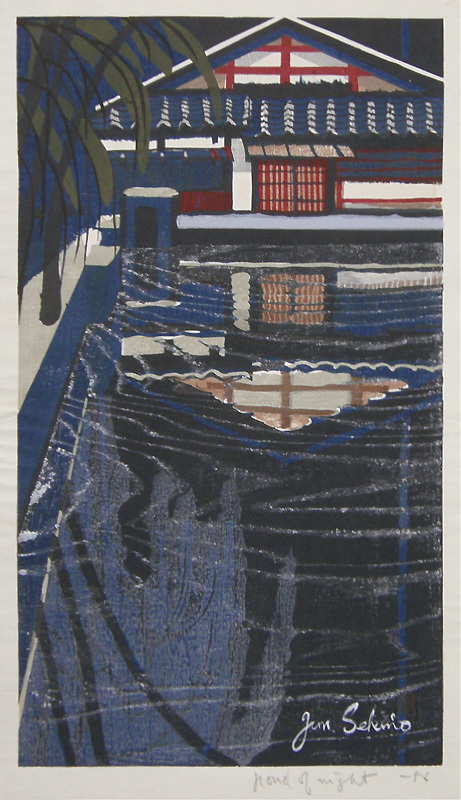
19th, 20th & 21st Century Fine Prints
707-546-7352 · fax 707-546-7924 · web: www.annexgalleries.com · email: artannex@aol.com
Pond of Night (also called: Night Pond in Kyoto) by Jun'ichiro Sekino

Pond of Night (also called: Night Pond in Kyoto)
Jun'ichiro Sekino
Pond of Night (also called: Night Pond in Kyoto)
Jun'ichiro Sekino
1914 - 1988 (biography)This beautiful impression, depicting a temple pond in Japan at night, uses mica to create the shimmering water in the pond and the grain of the woodblock to emphasize the ripples of the water. Sekino focuses on edges, the corner of the pond, the edges that define the pond and the gateway to a temple in the background, all creating a quiet intimate composition.
Helen Merritt, in her book 'Modern Japanese Woodblock Prints - The Early Years' notes about Sekino's work: "Once he acknowledged to himself that he was not at ease with nonobjective prints, he discovered his personal idiom in a simplified representational style...Essentially this is a carefully organized picture plane. Vertical and horizontal elements in the building relate harmoniously to the broad horizontal...with subtle asymmetrical balance...This is a distillation of the geometric and organic shapes that give the Japanese landscape its characteristic flavor."
This impression was purchased from T.Z. Shiota in San Francisco in the late 1950's. It is dated "-56," most impressions found on line are dated "57" and have are pencil editioned over 200, indicating that this may be an early proof, aside from the edition.
Jun’ichiro Sekino was born on October 23, 1914 in Aomori City, Aomori Prefecture, Japan, the son of an rice and fertilizer merchant. Sekino grew up in Aomori with Shiko Munakata, who was 11 years older, and whom he followed around on sketching trips, often carrying Munakata’s tools. This experience probably instilled his interest and love of art in the boy. From an early age on Sekino studied printmaking and oil painting. In 1936 he won a prize at Bunten for an etching. Bunten was part of the official government controlled art scene with juries who decided on the admission of artworks. Being accepted to these official exhibitions, was quite some success, and winning a prize was an even more remarkable achievement for the young artist.
In 1939 Sekino moved to Tokyo. He met and studied under Koshiro Onchi, the great mentor of the sosaku hanga print movement. During his art training Sekino had learned multiple disciplines, the Japanese woodblock method and Western techniques, like etching. Although he had some art training, Sekino was basically self-taught. His great paragons were the old Japanese and European masters – Sharaku, Hiroshige, Toulouse-Latrec, Dufy, Rembrandt and especially Albrecht Dürer.
The years before and during World War II was an extremely bad time for Japanese artists - especially for printmakers, whose success and livelihood often depended on art exports to Western countries, with the United States of America as the major foreign market for Japanese prints.
Sekino worked during the war years in an ammunition factory. Even the most basic resources for printmaking, like paper or ink, were rationed. Art production had come to a virtual standstill for Japanese artists between 1940 and 1945. After 1945 he slowly began to make his way to international fame. In the late 1940s he made a living doing book illustrations.
The artist's breakthrough came in the 1950s. In 1953 he had his first one-man show in Tokyo. With an official invitation by the Rockefeller Foundation and the American Japan Society Sekino came to the United States in 1958 for the first time, travelling to New York where he taught at Pratt Institute. From then on follows a long list of international exhibitions, prizes and frequent travels in North and South America and in Europe. The journey of 1958 was not his last trip to the United States. In 1963 Sekino taught printmaking at Oregon State University. After his return to Japan he taught at Kobe University in 1965.


